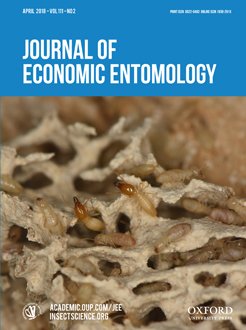Traditional identification of thrips species based on morphology is difficult, laborious, and especially challenging for immature thrips.To support monitoring and management efforts of thrips as consistent and widespread pests of cotton (Gossypium hirsutum L.), a probe-based quantitative PCR (qPCR) assay with crude DNA extraction was developed to allow efficient and specific identification of the primary species of thrips infesting cotton.The assay was applied to identify over 5,000 specimens of thrips (including 3,366 immatures) collected on cotton seedlings from Alabama, Georgia, North Carolina, South Carolina, andVirginia in 2016. One half of all adult samples were examined by morphological identification, which provided a statistically equivalent species composition as the qPCR method. Frankliniella fusca (Hinds) (Thysanoptera:Thripidae) was the dominant species across all the locations (76.8–94.3% of adults and 81.6–98.0% of immatures), followed by Frankliniella occidentalis (Pergande) (Thysanoptera:Thripidae) in Georgia, North Carolina, and Virginia (4.6–19% of adults and 1.7–17.3% of immatures) or Frankliniella tritici (Fitch) (Thysanoptera: Thripidae) in South Carolina (10.8% of adults and 7.8% of immatures). Thrips tabaci (Lindeman) (Thysanoptera: Thripidae) and Neohydatothrips variabilis (Beach) (Thysanoptera: Thripidae) were occasionally found among adults but were rarely present among immature thrips. These five species of thrips represented 98.2–100% of samples collected across the Southeast.The qPCR assay was demonstrated to be a valuable tool for large-scale monitoring of species composition of thrips at different life stages in cotton.The tool will contribute to a better understanding of thrips population structure in cotton and could assist with development and application of improved management strategies.
How to translate text using browser tools
28 February 2018
Molecular Identification of Thrips Species Infesting Cotton in the Southeastern United States
Hehe Wang,
George G. Kennedy,
Francis P. F. Reay-Jones,
Dominic D. Reisig,
Michael D. Toews,
Phillip M. Roberts,
D. Ames Herbert,
Sally Taylor,
Alana L. Jacobson,
Jeremy K. Greene
ACCESS THE FULL ARTICLE
It is not available for individual sale.
This article is only available to subscribers.
It is not available for individual sale.
It is not available for individual sale.

Journal of Economic Entomology
Vol. 111 • No. 2
April 2018
Vol. 111 • No. 2
April 2018
flower thrips
morphological
quantitative PCR
tobacco thrips
western flower thrips




